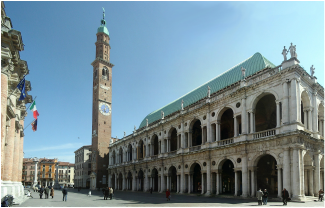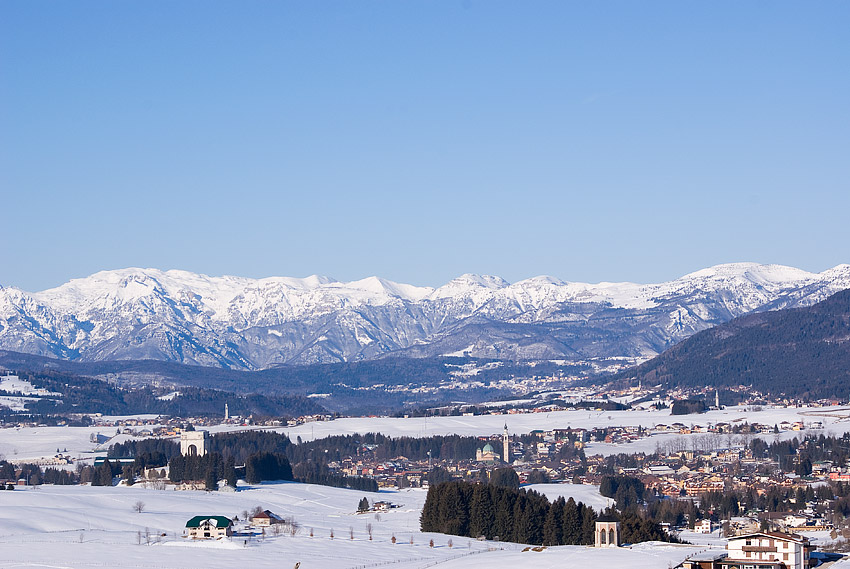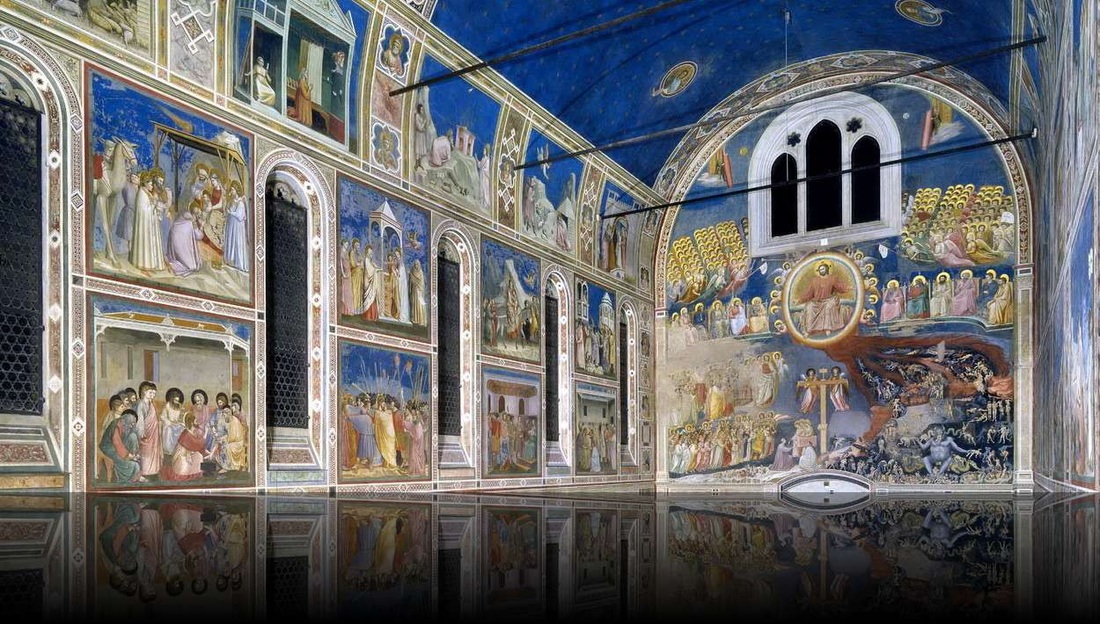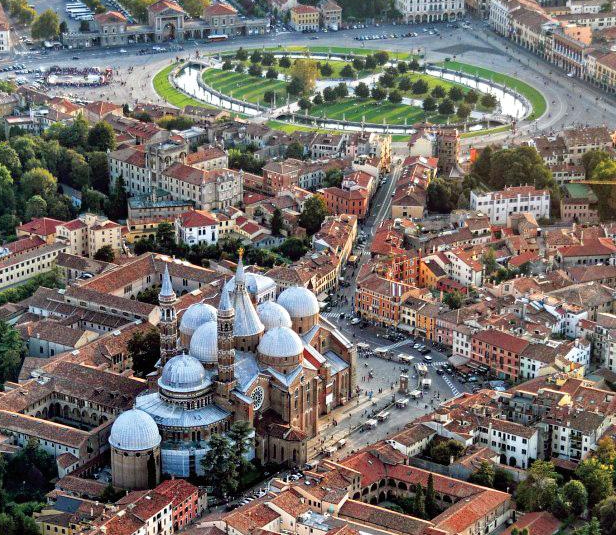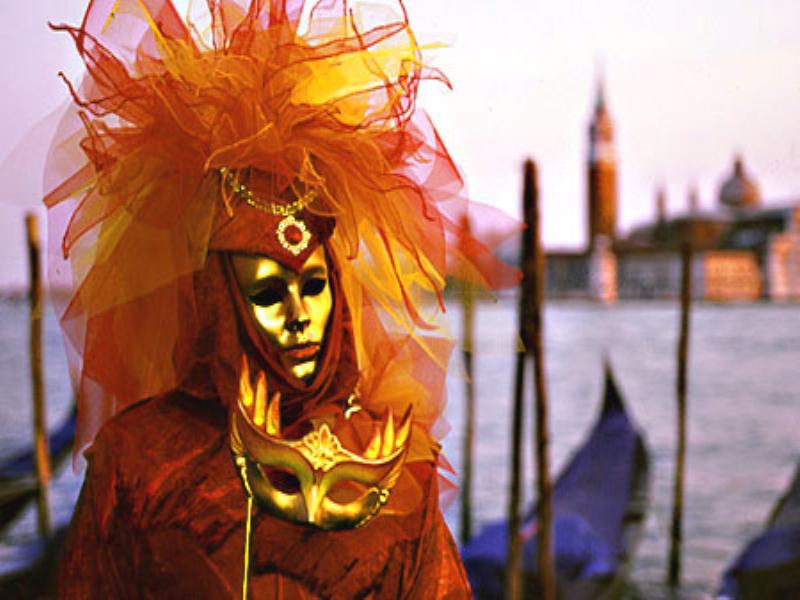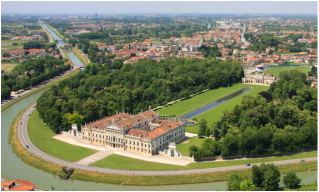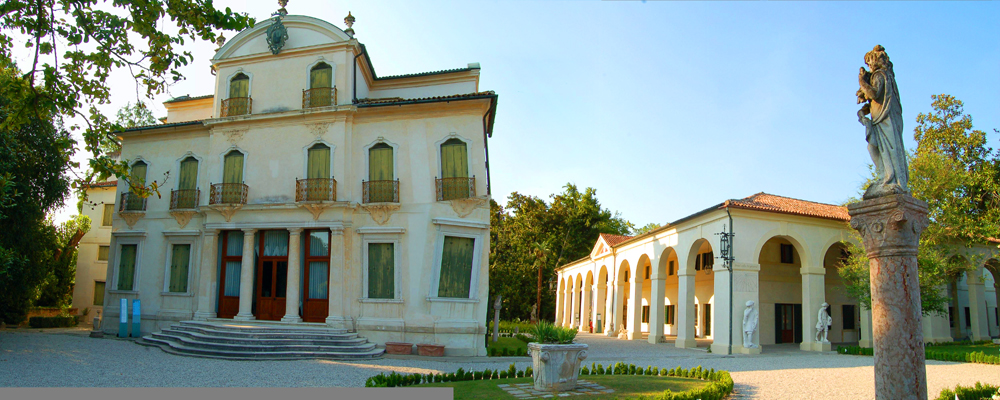|
|
VERONA
Verona, the city straddling the Adige river, has a wealth of archaeological finds almost equal to Rome "The Eternal City". An important example is the old Arena, the symbol of the city. The Arena was built in the city's largest piazza, the actual Piazza Bra. Completed around 30 AD, it is the third largest in Italy after Rome's Colosseum and the arena at Capua. It is 139 metres long and 110 metres wide, and could seat some 25,000 spectators in its 44 tiers of marble seats. The ludi (shows and gladiator games) performed within its walls were so famous that they attracted spectators from far beyond the city. The interior is very impressive and is virtually intact, and has remained in use even today for public events, fairs, theatre and open-air opera during warm summer nights. And then in Verona there are the squares, the churches and Scaliger Arks hosting the body of CanGrande della Scala, lord of Verona died suddenly in July 1329 after conquering the city of Treviso. Depth study and analysis revealed that the cause of death was due to the hiring of a substance derived from a plant widely used in medicine and known as digital, but that can also be a powerful poison! Verona, the city of Love ... here is the setting for the story of Romeo and Juliet, the ill-fated lovers bound by eternal love and made known by the Shakespeare's tragedy. Not everyone knows that the story was written by Luigi da Porto, a nobleman of Vicenza. |
|
|
VICENZA
Vicenza, at the northern base of Monte Berico, straddling the Bacchiglione River, is approximately 60 kilometres (37 mi) west of Venice and 200 kilometres (120 mi) east of Milan. Vicenza is a thriving and cosmopolitan city, with a rich history and culture, and many museums, art galleries, squares, villas, churches and elegant Renaissance Palazzi (historical buildings). In 1994 UNESCO inscribed "Vicenza, City of Palladio" on its list of World Heritage Sites. In 1996 the site was expanded to include the Palladian villas outside the core area, and accordingly renamed "City of Palladio and the Palladian Villas of the Veneto". Andrea Palladio (1508 – 1580) was a genius, an Italian architect active in the Republic of Venice. Palladio, influenced by Roman and Greek architecture, primarily by Vitruvius, is widely considered the most influential individual in the history of Western architecture. All of his buildings are located in what was the Venetian Republic, but his teachings, summarized in the architectural treatise, "The Four Books of Architecture", gained him wide recognition. Additionally, about one fifth of the country's gold and jewelry is made in Vicenza, greatly contributing to the city's economy. Another important sector is the engineering/computer components industry (Federico Faggin, the microprocessor's co-inventor, was born in Vicenza). The Church of St. Mary of Mount Berico (Italian: Basilica della Madonna (Our Lady) di Monte Berico) is a Roman Catholic and minor basilica in Vicenza. The church is a Marian shrine, and stands at the top of a hill which overlooks the city. According to the legend, the Blessed Virgin appeared on the hill twice to a peasant worker named Vincenza Pasini; the first time occurred on March 7, 1426, the second on August 1, 1428. At this time in the Veneto, the people and economy had been suffering from a terrible plague for years. The Madonna promised that if the people of Vicenza built a church on the top of the hill she would rid them of the plague. The people kept their promise and the church was built in 3 months. The original church later became a sanctuary. |
|
|
The PROVINCE of VICENZA: ASIAGO, BASSANO DEL GRAPPA, MAROSTICA
- Asiago (m 1000 - 3284 ft) is the name of both a minor township (population roughly 6,500) and the surrounding plateau region (the Altopiano di Asiago or Altopiano dei Sette Comuni, Asiago plateau) in the Province of Vicenza in the Veneto region of Northeastern Italy. It is near the border between the Veneto and Trentino-Alto Adige/Südtirol regions in the foothills of the Alps, and about equidistant (60 km) from the major cities of Trento to the west and Vicenza to the south. The Asiago region is the origin of Asiago cheese. The town was the site of a major battle between Austrian and Italian forces on the Alpine Front of World War I. It is a major ski resort destination as well as the site of the Astrophysical Observatory of Asiago, operated by the University of Padua. - Bassano del Grappa. Bassano is located at 129 metres (423 feet) above sea level. Its highest point is at 1,276 m (4,186 ft). The city lies at the foothills of the Venetian Prealps, where river Brenta comes out the southern end of Canal di Brenta (also called Valbrenta 'Brenta valley') and flows in the lowlands at the borders of Vicenza, Treviso and Padua provinces. Bassano Del Grappa is also famous for inventing the spirit Grappa, traditionally an after-dinner drink made from pomace (discarded grape seeds, stalks, and stems). The artist Jacopo Bassano was born, worked, and died in Bassano and took it as his surname. The wooden covered Bridge, or Ponte degli Alpini, on the Brenta River is very famous, it was designed in 1569 by the architect Andrea Palladio to replace a pre-existing construction existing since 1209. The bridge was destroyed in 1748, and was rebuilt three years later. The last rebuilding was made by the Alpini after the II World War bombing. - Marostica. Famous for the game of living chess, which takes place every two years in the homonymous square in the center of this town, a fine example of the "walled city" with medieval Castles. |
|
|
TREVISO E LA MARCA TREVIGIANA
- Treviso, entirely built on water, is crossed by two rivers: the Sile and Cagnan, as mentioned in Dante's Divine Comedy. These resurgence rivers - always with the same level and the same temperature - have characterized the life of the inhabitants: mills, transport, commercial activities and the production of the famous Radicchio Rosso di Treviso. The water helps to create a charming atmosphere among the houses that are reflected and the luxuriant nature: so the ancient Tarvisium is called "Little Venice". The historic center of Treviso is characterized by the presence of many medieval buildings: the Loggia dei Cavalieri, where young noblemen gathered to converse; the Palazzo dei Trecento, still elegantly frescoed and used; the Church of San Francesco with the graves of the children of Dante and Petrarch; the Church of St. Nicholas with the famous image of the first glasses in art history; the evocative Church of Saint Lucia with the relic of the Holy and the fresco of the Madonna of the Butterfly. After numerous Lordships (da Romano, da Camino, from Carrara, ...), in 1339 Treviso passed under the power of Republic of Venice. - Maser. The Villa Maser (Villa Barbaro) is a masterpiece of Andrea Palladio. The Villa, UNESCO World Heritage, is still an active farm, just like the two brothers Barbaro, the ancient owners, wanted in the XVI Century. Open all year, retains the charm of the villa occupied by the owners and you can enjoy the extraordinary beauty and magic atmosphere in different seasons. Roses, wisteria and climbing bignonia welcome in the courtyard entrance. Paolo Veronese frescoed six interior rooms and outside you can admire the Nymphaeum with stucco work by Alessandro Vittoria. - Asolo, dominated by the famous Rock Braida. A wall naked and inaccessible with a single little door entrance, a compact ellipse and an exceptional view. In Asolo two women of great character lived: Caterina Cornaro - Queen of Cyprus and Eleonora Duse. |
|
|
PADOVA
Padua stands on the Bacchiglione River, 40 kilometres (25 miles) west of Venice and 29 km (18 miles) southeast of Vicenza. The Brenta River, which once ran through the city, still touches the northern districts. Its agricultural setting is the Venetian Plain (Pianura Veneta). To the city's south west lies the Euganaean Hills, praised by Lucan and Martial, Petrarch, Ugo Foscolo, and Shelley. It hosts the renowned University of Padua, almost 800 years old and famous, among other things, for having had Galileo Galilei among its lecturers. The city is picturesque, with a dense network of arcaded streets opening into large communal piazze, and many bridges crossing the various branches of the Bacchiglione, which once surrounded the ancient walls like a moat. The Scrovegni Chapel (Italian: Cappella degli Scrovegni) is Padua's most famous sight. It houses a remarkable cycle of frescoes completed in 1305 by Giotto. It was commissioned by Enrico degli Scrovegni, a wealthy banker, as a private chapel once attached to his family's palazzo. The most famous of the Paduan churches is the Basilica di Sant'Antonio da Padova, locally simply known as "Il Santo". The bones of the saint rest in a chapel richly ornamented with carved marbles, the work of various artists, among them Sansovino and Falconetto. The basilica was begun about in 1230 and completed in the following century. Tradition says that the building was designed by Nicola Pisano. It is covered by seven cupolas, two of them pyramidal. There are also four beautiful cloisters to visit. The belltower has 8 bells. One of the best known symbols of Padua is the Prato della Valle, a 90,000 m2 (968,751.94 sq ft) elliptical square. This is one of the biggest in Europe. In the centre there is a wide garden surrounded by a ditch, which is lined by 78 statues portraying famous citizens (only one is a woman). It was created by Andrea Memmo in the late 18th century. |
|
|
VENEZIA
Venice lies directly on the sea, sited on a group of 118 small islands separated by canals and linked by bridges. The city historically was the capital of the Republic of Venice. Venice has been known as the "La Dominante", "Serenissima", "Queen of the Adriatic", "City of Water", "City of Masks", "City of Bridges", "The Floating City", and "City of Canals". The Republic of Venice was a major maritime power during the Middle Ages and Renaissance, and a staging area for the Crusades and the Battle of Lepanto, as well as a very important center of commerce (especially silk, grain, and spice) and art in the 13th century up to the end of the 17th century. This made Venice a wealthy city throughout most of its history. It is also known for its several important artistic movements, especially the Renaissance period. Venice has played an important role in the history of symphonic and operatic music, and it is the birthplace of Antonio Vivaldi. Subsidence, the gradual lowering of the surface of Venice, leads to the seasonal phenomenon of Acqua alta where much of the city's surface is covered by high water. The historical part of the city is traditionally divided in six boroughs: Dorsoduro, Santa Croce, San Polo, San Marco, Cannaregio e Castello. The districts of the old city are articulated around the double bend of the Grand Canal, the main waterway which runs an extensive network of about 150 smaller canals. Venezia is known thanks to Piazza San Marco, la Basilica, il Palazzo Ducale, il Campanile, il Ponte dei Sospiri, la Libreria Marciana e La Fenice, famous Theatre risen again from fire of 1836 and 1996. But very exciting is a walking to discover the “unknown” Venice : San Polo and Santa Croce, San Rocco, la Chiesa dei Frari, campo San Polo, le Carampane, the old red light district and the markets of Rialto … |
|
|
THE VILLAS OF RIVIERA DEL BRENTA
Riviera del Brenta is the coastline of the Naviglio del Brenta (Brenta River) which runs from Padua through the Veneto countryside to Fusina, a part of Venice. It is navigable by river boats, whose best example is the famous Burchiello, which used to carry Venetian noblemen from Venice to the countryside and it is now a tourist attraction. This is an area with high historical value-landscaped. From 16th to 18th century many Venetian aristocratic families built their beautiful villas here: - VILLA PISANI. Also named "la Nazionale", represents one of the most famous examples of Venetian Villa along the Brenta Riviera; it is in Stra and occupies an entire loop of the Brenta Canal, it covers an area of 11 hectares and has an outer perimeter of about 1,500 meters. 140 rooms ... Tiepolo ... the park with the labyrinth ... - VILLA WIDMANN. Villa Seriman, Foscari Widmann-Rezzonico is located in the resort Riscossa in the municipality of Mira. Today it is owned by the Province of Venice and is used as a venue for exhibitions and cultural and social events. Facing Villa Seriman there is Barchessa Valmarana. - VILLA FOSCARI named LA MALCONTENTA. The Villa was designed by Palladio. Its architecture is intact and it reflects itself in the Brenta in resort Malcontenta. There are various explanations about the origin of the nickname, among these it seems that here a noblewoman was relegated to atone for her ... excesses. Others report that because of the frequent flooding of the river Brenta they used to say "Brenta sore happy"! |
Program
Day 1: Verona
Flight to Verona. Passengers on Tour arrive at the Airport and pick up their baggage. Transfer by GT Bus to the center of Verona, join a local guide for a tour of ancient and modern Verona.
Verona owns important archaeological fields like the famed Arena actually the well-known temple of Opera.
Visit the Squares, the Churches and the medieval Arche Scaligere.
Lunch. The visit ends at the places of Romeo and Juliet, the unfortunate lovers of Shakespeare’s tragedy.
Transfer to the hotel. Accommodation in reserved rooms. Dinner and overnight.
Day 2: Vicenza
Breakfast at the hotel. In the morning transfer to Vicenza e visit the Palladio’s city with the local guide. Andrea della Gondola named PALLADIO is a very famous architect of XVI century. His style is also recognized in the White House in Washington.
Lunch. In the afternoon visit the Villa Almerico Capra la Rotonda. The plan turns of 45° referring cardinal points to permit the best exposition to the sun. After the visit Basilica di Monte Berico.
Transfer to the hotel. Accommodation in reserved rooms. Dinner and overnight.
Day 3: Province of Vicenza – Asiago, Bassano del Grappa, Marostica, Lugo di Vicenza.
Breakfast at the hotel and starting for a full immersion in the province of Vicenza to know places and traditions of Veneto’s heart. Transfer to Asiago (1.000 m asl), renowned little mountain city and famous ski resort.
Tasting cheeses. Stop at the military memorial.
Leaving to Bassano del Grappa, one of the most developed city in Veneto known for traditional grappa.
Lunch . In the afternoon visit Bassano del Grappa, historical squares, buildings, churches and the famous wooden bridge.
To follow visit a Distilleria to appreciate the history and flavor of the best grappa and spirit.
Transfer to walled city Marostica famous for the game of living chess in the square.
In the evening arrival at the hotel to prepare yourself for the Gala dinner in Villa Godi Malinverni at Lugo di Vicenza.
At the end return to the hotel and overnight stay.
Day 4: Treviso
Breakfast at the hotel. Transfer to Treviso, join the local guide and visit a picturesque city named “Little Venice”.
Besides of many ancient family mansions, Treviso has a lot of churches and in one of them, Saint Lucia’s Church, there is Butterfly’s Madonna. In St. Nicolò’s Church you can see the first glasses in art history.
After lunch in the restaurant, transfer to Asolo through the “Way of Prosecco” famous sparkling wine.
Arrival at Villa di Maser, a magnificent manor surrounded by a dreamy countryside. Visit internal rooms frescoed by Veronese and external gardens. At the end a guided rewarded wine-tasting in a historical winery.
Visit Asolo, famous for the Rock and for two women: the Cyprus’ Queen Caterina Cornaro and the famous Italian actress of theater Eleonora Duse. Free time.
Dinner in a renowned Restaurant at Castelfranco Veneto.
Return to the hotel and overnight stay.
Day 5: Padua
Breakfast at the hotel. Transfer to Padua, join the local guide and visit historical center with colorful squares: Piazza dei Signori, delle Erbe e dei Frutti, monuments and churches: Palazzo della Ragione, Duomo of Santa Maria Assunta and Battistero. Walk from ancient Palazzo del Bò, home of prestigious University to Cafe Pedrocchi (the “Cafe without doors”).
Lunch. In the afternoon optional visit the Cappella degli Scrovegni and Basilica of Saint (the “saint without name”), because Saint Anthony is called simply The Saint. The Basilica is visited by approximately 8 million pilgrims a year and is the third pilgrimage center in Europe after Roma and Lourdes.
Free time for shopping. Accommodation in reserved rooms. Dinner and overnight in the hotel.
Day 6: Riviera del Brenta
Breakfast at the hotel. A full day to visit the famed Villas along Riviera del Brenta.
36 km of scenic beauty: a framework with art and culture, nature and history of villa’s civilization.
In the morning Villa Foscarini Rossi e Villa Pisani with park and labyrinth.
Lunch. In the afternoon Villa Widmann, Barchessa Valmarana and Villa Foscari named La Malcontenta.
In the evening arrival at the hotel. Accommodation in reserved rooms. Dinner and overnight.
Day 7: Venezia
Breakfast at the hotel. Venice, the magic city on the water …
In the morning visit the well-known places: Palazzo Ducale, Piazza San Marco, BellTower, the Bridge of Sighs, and in the afternoon … the Venice ”Noir” with a local guide.
At the end a jewel: La Fenice, famous Theatre risen again from fire of 1836 and 1996.
Free time for shopping. Transfer to the airport. Ending of our services.
Day 8: Venezia (Optional + 1 day) - Free day for insights and shopping
Breakfast in hotel. Free day.
Transfer to the airport. Ending of our services.
For information and reservation: Tel. +39 0445 372326
Flight to Verona. Passengers on Tour arrive at the Airport and pick up their baggage. Transfer by GT Bus to the center of Verona, join a local guide for a tour of ancient and modern Verona.
Verona owns important archaeological fields like the famed Arena actually the well-known temple of Opera.
Visit the Squares, the Churches and the medieval Arche Scaligere.
Lunch. The visit ends at the places of Romeo and Juliet, the unfortunate lovers of Shakespeare’s tragedy.
Transfer to the hotel. Accommodation in reserved rooms. Dinner and overnight.
Day 2: Vicenza
Breakfast at the hotel. In the morning transfer to Vicenza e visit the Palladio’s city with the local guide. Andrea della Gondola named PALLADIO is a very famous architect of XVI century. His style is also recognized in the White House in Washington.
Lunch. In the afternoon visit the Villa Almerico Capra la Rotonda. The plan turns of 45° referring cardinal points to permit the best exposition to the sun. After the visit Basilica di Monte Berico.
Transfer to the hotel. Accommodation in reserved rooms. Dinner and overnight.
Day 3: Province of Vicenza – Asiago, Bassano del Grappa, Marostica, Lugo di Vicenza.
Breakfast at the hotel and starting for a full immersion in the province of Vicenza to know places and traditions of Veneto’s heart. Transfer to Asiago (1.000 m asl), renowned little mountain city and famous ski resort.
Tasting cheeses. Stop at the military memorial.
Leaving to Bassano del Grappa, one of the most developed city in Veneto known for traditional grappa.
Lunch . In the afternoon visit Bassano del Grappa, historical squares, buildings, churches and the famous wooden bridge.
To follow visit a Distilleria to appreciate the history and flavor of the best grappa and spirit.
Transfer to walled city Marostica famous for the game of living chess in the square.
In the evening arrival at the hotel to prepare yourself for the Gala dinner in Villa Godi Malinverni at Lugo di Vicenza.
At the end return to the hotel and overnight stay.
Day 4: Treviso
Breakfast at the hotel. Transfer to Treviso, join the local guide and visit a picturesque city named “Little Venice”.
Besides of many ancient family mansions, Treviso has a lot of churches and in one of them, Saint Lucia’s Church, there is Butterfly’s Madonna. In St. Nicolò’s Church you can see the first glasses in art history.
After lunch in the restaurant, transfer to Asolo through the “Way of Prosecco” famous sparkling wine.
Arrival at Villa di Maser, a magnificent manor surrounded by a dreamy countryside. Visit internal rooms frescoed by Veronese and external gardens. At the end a guided rewarded wine-tasting in a historical winery.
Visit Asolo, famous for the Rock and for two women: the Cyprus’ Queen Caterina Cornaro and the famous Italian actress of theater Eleonora Duse. Free time.
Dinner in a renowned Restaurant at Castelfranco Veneto.
Return to the hotel and overnight stay.
Day 5: Padua
Breakfast at the hotel. Transfer to Padua, join the local guide and visit historical center with colorful squares: Piazza dei Signori, delle Erbe e dei Frutti, monuments and churches: Palazzo della Ragione, Duomo of Santa Maria Assunta and Battistero. Walk from ancient Palazzo del Bò, home of prestigious University to Cafe Pedrocchi (the “Cafe without doors”).
Lunch. In the afternoon optional visit the Cappella degli Scrovegni and Basilica of Saint (the “saint without name”), because Saint Anthony is called simply The Saint. The Basilica is visited by approximately 8 million pilgrims a year and is the third pilgrimage center in Europe after Roma and Lourdes.
Free time for shopping. Accommodation in reserved rooms. Dinner and overnight in the hotel.
Day 6: Riviera del Brenta
Breakfast at the hotel. A full day to visit the famed Villas along Riviera del Brenta.
36 km of scenic beauty: a framework with art and culture, nature and history of villa’s civilization.
In the morning Villa Foscarini Rossi e Villa Pisani with park and labyrinth.
Lunch. In the afternoon Villa Widmann, Barchessa Valmarana and Villa Foscari named La Malcontenta.
In the evening arrival at the hotel. Accommodation in reserved rooms. Dinner and overnight.
Day 7: Venezia
Breakfast at the hotel. Venice, the magic city on the water …
In the morning visit the well-known places: Palazzo Ducale, Piazza San Marco, BellTower, the Bridge of Sighs, and in the afternoon … the Venice ”Noir” with a local guide.
At the end a jewel: La Fenice, famous Theatre risen again from fire of 1836 and 1996.
Free time for shopping. Transfer to the airport. Ending of our services.
Day 8: Venezia (Optional + 1 day) - Free day for insights and shopping
Breakfast in hotel. Free day.
Transfer to the airport. Ending of our services.
For information and reservation: Tel. +39 0445 372326



